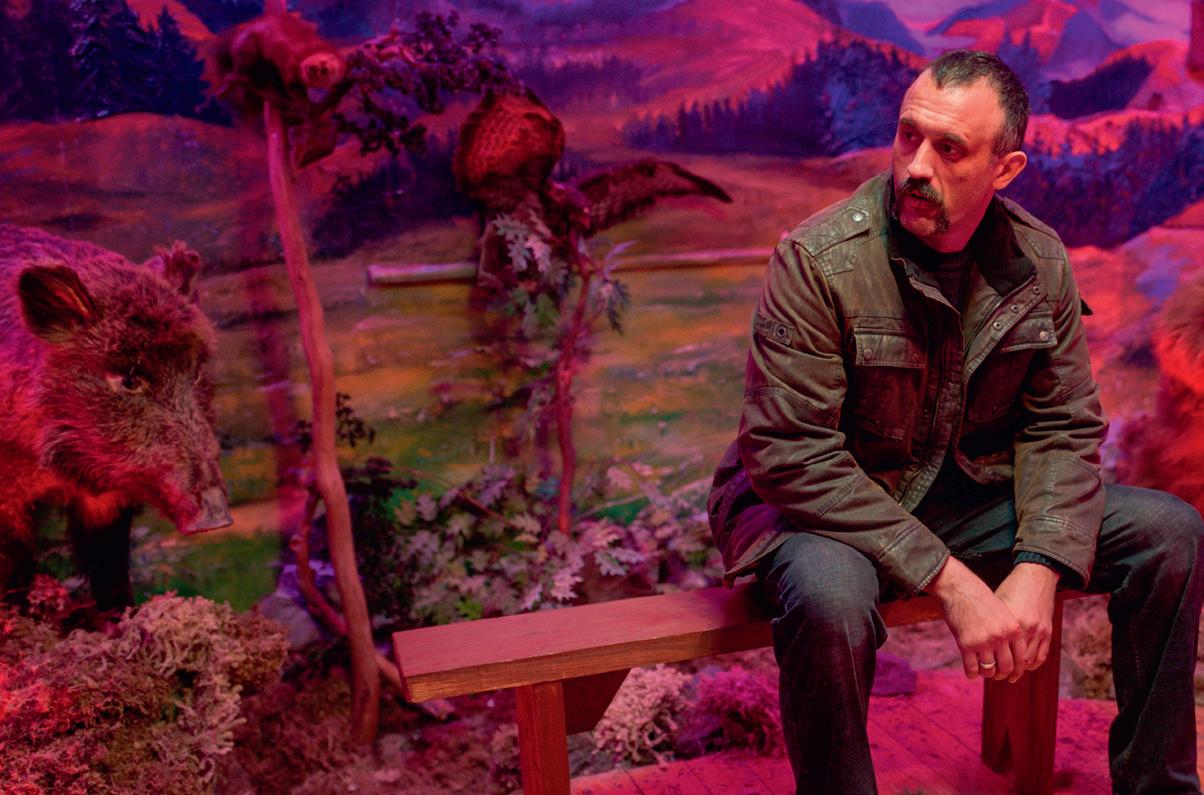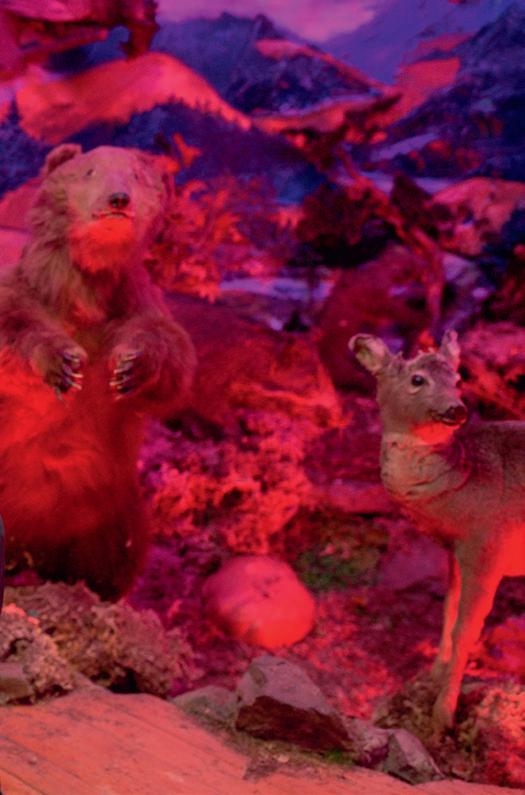
9 minute read
COVER STORY Rock in a Hard Place
Rock
in a Hard Place
This May, the new, vibrant Ukrainian feature film Pamfir will be premiered in the Quinzaine des Réalisateurs section of Cannes Film Festival. It is a crime story with an ethnic bent that takes place in Ukraine, near the Romanian border, and shows a man, who has been working abroad for a long time, returning home where he’s forced by the circumstances to pick up his old trade of smuggling to pay some debts and settle some scores. On this occasion, we had a brief talk with the film’s director Dmytro Sukholytkyy-Sobchuk.

Dmytro, Pamfir is a film with a distinct feel because of the traditional folk elements and themes in the film. How did you come to use these?
First, I want to say that the folklore elements are more like a background. It’s important for the identification – of my characters, of myself – but I don’t want to set is as the main thing in my film. The main things are my characters’ personality and human destiny.
The events take place in a very special area, a place I am from, Bukovina. It’s a region on the Ukrainian-Romanian border, and we also have a border with Moldova nearby, so it is a place where you can see that life is multi-cultural, and this has an influence on a persona. When you depart this area, one lives with the perpetual feeling that one belongs to the place. During the shooting and preparation, I was thinking I should show the local flavour as part of their life – what they do, how they live, what they love. It has a very strong influence on regular life.
Your main character is a man who is confronted with very difficult choices. What drew you to that kind of character, where did he come from? When you have a person, who you want to find something out about, then you will most likely start talking to this person in real life. They might give you a very subjective account of the moments in their life when their destiny took a turning point, and everything changed. The character who we meet has had his turning points in the past, and he also has them now, in the present. It was important for me to show someone who has become more powerful because of those choices, and if you put a choice in front of him, he can make the hardest decision. It’s something that connects you to a very existential level of a human being. We all go through these turning points in our life. In this story, I tried to show that in the main scenes, emotional moments, we see how this existential surge goes through this powerful person, and how he manages the situation, and how he goes
Director Dmytro Sukholytkyy-Sobchuk working on the set of Pamfir.


on living with his choices. The decision he makes is neither bad nor good, it just needs to be made for his family. A situation where a person with a strong personality can make this choice, and take the responsibility on himself. For more than two years, I was looking for someone who could play this character, and finally I found Oleksandr Yatsentyuk. He’s a professional actor, and Pamfir is his debut film. He had played in some shorts and TV series before. He had a very deep and strong paternal characteristic. Like someone who can take care of you. Of himself, and people who depend on him. I was lucky to find him.
In the film, there is one short reference to his alias, Pamfir, just briefly. Everybody asks what his name means but I wanted to have it like that in the film – only referred to once, a couple of seconds. My idea was also that the person is more important than the exact meaning of his name.
Do you see Pamfir and his situation as something that is descriptive of the war situation in Ukraine in general, or an allegory in some way? Yes, for sure. When we look at Pamfir, we might find out through him why our soldiers, volunteers, and warriors are so strong, brave, unbreakable. Also, everybody else, who has stood through Maidan, or survived Russian aggression. I would say it’s typical of the Ukrainian mentality to stand our own ground – the land, the nation, community, family. There is a scene in the film between Pamfir and his son, where the son proposes to sell his bike in order to pay the debt. In the background, we see scenes from Maidan on TV. Our film takes place before the Ukrainian war we are in right now, but we refer to the conflict as part of their life. There is also a similar connection between the twin brothers and Pamfir, because the twins’ father had been Pamfir’s friend but was killed in Donbass by Russians. It’s there, but only in the background.
Did the shooting period turn out to be what you expected? Did the story shift in the process? We had a very long rehearsal period, almost three months, so our preparation during rehearsals was very detailed. We also practised all the camera movements. We planned the one-shot scenes very carefully. We definitely had some changes during the shooting and some surprises, but we relied on dramaturgy, and had a pretty good idea of how the characters would react in a certain situation. Another thing: we shot this movie on an iPhone first, and then filmed it for real, so we would know in advance, exactly, how the scenes are going to look. It was like some choreography exercise with everybody, the actors, the DoP, the crew.
According to Sukholytkyy-Sobchuk, the preparation during rehearsals for Pamfir was very detailed.
The long shots in the film are really amazing and you use them quite freely. Did you have the idea from the start that you would like to tell a story via long shots and use less cutting? It was planned from the beginning. For me, it was very important to tell the story through pictures, like paintings. If I could compare it to something, we tried to get the ef-

fect of works by Hieronymus Bosch. For me, it was important to put my character in situations where you could see that it is one “scene” from his life. Every episode is like a snapshot of his life – like a Brueghel painting. The story we tell should link with the moment, and we should identify with this person. We should be linked with his situation, and we cannot cut mid-scene, because we might cut away from something that may be important for him, and we lose the focus. The direction was just to film the scenes and identify which parts we could leave intact, without editing. In only one scene, with the singing in the church, we break the rules. The choir song is still in real time, 4.5 minutes, but we cut between the choir and the parents. But the viewer still remains in the moment, with the singer, we do not break time. The song is like a long take beneath, uniting the scene.
What are your expectations of Cannes? Will you be there? Yes, I hope I will get permission and can be there. For me, the sense of a normal life has almost disappeared by now, so, Cannes and life there, is like a bridge to a memory of a peaceful life, connecting it with my own life, my family, my surroundings. All in all, we can accept that this normalcy has shown up in our life again, and we can show in Cannes what kind of a unique reality we have in Ukraine, and also the unique character of our nation. To share this will be a pleasure and an honour. I want to share who we are, and maybe, in this context, the audience will understand why we stand so bravely.
Will you be using Cannes as a platform for relaying some sort of a message? Definitely. For me, it’s a platform where I can talk mostly about my country, our situation. For Ukraine, it’s extremely important to have a voice in the international arena, and right now it doesn’t matter who you are – a director, a writer, or a medicine worker. If we have the possibility to address an international audience, it will be about what is happening in our country, what our country is going through, and what steps should be taken to stop Russian aggression.
What is the documentary project you mentioned in the beginning? I am making a documentary about sculptors who started to make anti-tank obstacles during the Ukrainian war. It’s for The New Yorker, I am working with them at the moment. EF

Artem Koliubaiev co-producer, Ukraine:
It was a hard production cycle because of COVID firstly, and then the war. It was a tough journey for all of us, and I hope our hard work will be rewarded. It’s a really good film, and I’m really glad that Sasha asked me to be part of the team. It’s a really great opportunity for Ukraine to be selected in the Cannes programme, because it gives us a chance to explain to the world what is happening. I am now the Head of the Film Board at the Ukrainian Film Fund, in charge of all Ukrainian cinematography. And now we are trying to explain to the world that we need to stop Russian propaganda, and Russian films in all festivals, because this has become a tool of manipulation. For Russia to be presented in the official selection of Cannes is very bad for Ukraine. We plan to boycott them and initiate some activities to protect our Ukrainian culture.
Aleksandra Kostina
producer, Ukraine:
Pamfir was shot during COVID times, from October 2020 to February 2021. The whole film was shot on location, in the Carpathian Mountains. We made two trips, because we needed to have different seasons in the film. The weather distinguishes the Photo by Valentyna Lykiantseva three acts of the film. A beautiful beginning of the story characterized by a golden Autumn, the weather turns damp and muddy in late Autumn, when the protagonist gets stuck in problems, and in the finale, everything is covered with snow…
PAMFIR
• A fiction feature film, 106 min, Ukrainian-FrenchPolish-Chilean co-production. • Producers Aleksandra Kostina (Bosonfilm, UA); Jane Yatsuta, Laura Briand (Les Films d’Ici, FR); Bogna Szewczyk, Klaudia Smieja-Rostworowska (Madants, PL); Giancarlo Nasi Quijote Films (CL). Co-producers Artem Koliubaiev (Mainstream Pictures, UA), Adolf El Assal (Wady Films, LU), Adam Gudell (Moderator Investycje, PL), Alyona Tymoshenko (UA), Silvana Santamaria (DE). • Directed by Dmytro Sukholytkyy-Sobchuk; cinematographer Nikita Kuzmenko; editor Nikodem Chabior; composer Laëtitia Pansanel-Garric; sound design by Serhiy Stepanskyy, Matthieu Deniau. The main cast: Oleksandr Yatsentyuk, Stanislav Potiak, Solomiya Kyrylova, Olena Khokhlatkina, Myroslav Makoviychuk, Ivan Sharan.






